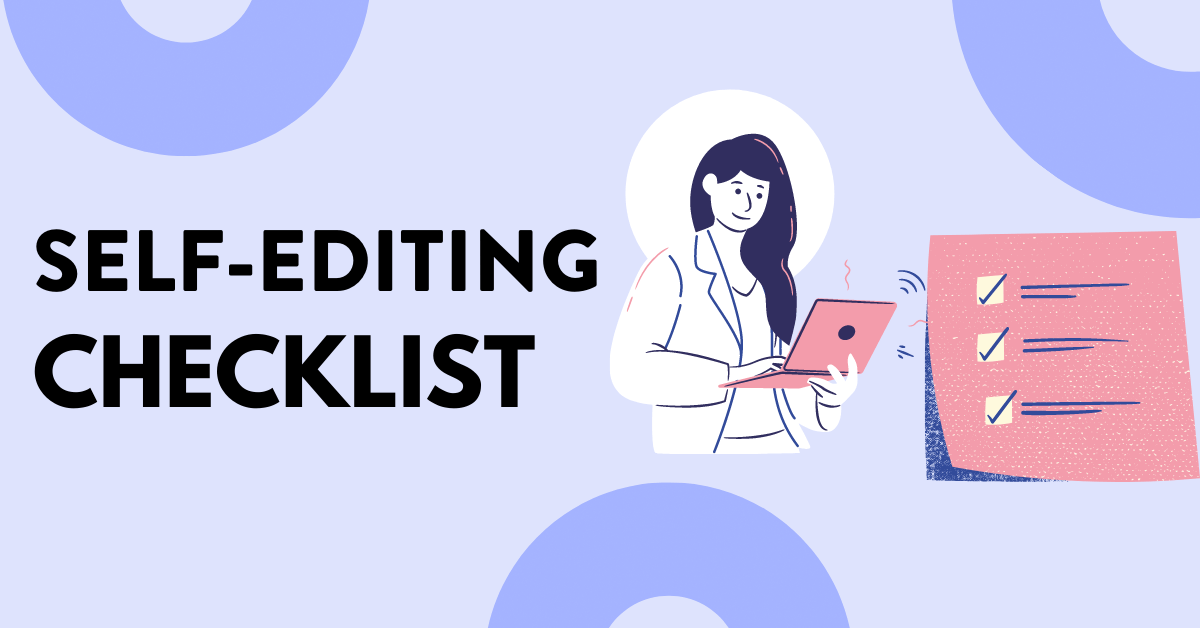 If you’re like me, you go through the same editing motions with every single piece of writing.
If you’re like me, you go through the same editing motions with every single piece of writing.
Why not change it up?
Consult these 15 innovative editing strategies and you’ll find a way to edit your book into greatness.
By following these, you’ll strike the perfect balance between copy editing (grammar and spelling mistakes) and content editing (character and plot development). Though this article starts more copy-heavy and ends more content-heavy, I believe it’s important to integrate the two as much as possible even while focusing on one or the other. Not only does keeping an open mind foster creativity that will enhance your writing — it allows you to catch more of those pesky typos!
Just remember: Editing is just as much a creative process as writing. It’s not mindless drudgery, it’s a chance once again to get creative.
5 Rereading Strategies
 This tried and true technique cannot be emphasized enough. No matter how good you are at avoiding typos, some are sure to slip by in any first draft (or second…or third…etc). Plus, by knowing that you will be coming back later to iron out the copy errors, you will be able to focus on writing for creative purposes instead of typographic perfection.
This tried and true technique cannot be emphasized enough. No matter how good you are at avoiding typos, some are sure to slip by in any first draft (or second…or third…etc). Plus, by knowing that you will be coming back later to iron out the copy errors, you will be able to focus on writing for creative purposes instead of typographic perfection.
Spellcheck is the ultimate frenemy. Though it will save you from time to time, it’s more than likely to become a crutch if you trust it to do the editing for you. Rereading is the most basic way to combat this, but to avoid going on autopilot, you must develop ways to stay alert so that you catch as many mistakes as possible. Try a few of these techniques to keep your mind fresh:
1. Start in the Middle
It’s important to break your normal flow when editing, and starting in the middle does just this. Instead of editing top-to-bottom, pick a paragraph in the middle of your piece. How does it connect thematically to what surrounds it? Does the tone match? Did you repeat any words or ideas? Even if you’ve read your whole work a few times already, reading one paragraph in isolation and then branching out from it will give you a new perspective.
2. Read Out Loud
This will force you to read slowly and carefully. It will also help you find out how natural your dialogue is. Do the individual characters’ voices jump off the page, or are they too homogeneous? Are your sentences artistically poignant, or are they long and rambling? Reading aloud also gives you a chance to imagine your work as an audiobook, and a little motivation is well-deserved as you proceed with the at-times strenuous process of editing.
If you’re feeling extra adventurous, use different character voices and maybe even some accents. You might just figure out how to nail a character’s tone better than you did before! It’s always great to add an extra sense.
3. Make Google Read
Put Google Translate to work by copying and pasting your manuscript and listening to it read back. Similar to reading out loud, this method allows you to gain distance from your piece and get a clearer, more objective perspective. Plus, you won’t be able to resist laughing at that ridiculous, computerized voice.
4. Play With Extremes
Take note of your shortest and longest sentences. Rewrite a short sentence as a long sentence and vice versa. Add in some overstatement and understatement. See how much information you can convey with few words, and see how long you can drag out a single moment of seemingly little significance. Make art out of nothing; turn it into something.
Give attention to the parts of the story that didn’t take much thinking. Simplify the parts that are complex and took forever to write. Make up a word or two. Smooth it all out, and then shake it all up. Repeat.
5. Mess With Words
Notice your repeated words; circle and replace them. Experiment with alliteration, assonance, and poetic meters. Rename your characters in your head with one adjective, and think of them as that word for a chapter. Write a metaphor when one isn’t needed. Make it work. This may all seem like experimenting, because it is. If you’re done experimenting, you’re done writing. If you can’t edit creatively, you can’t edit at all.
10 Ideas for Knuckle-Deep Revisions
 Don’t edit your original document. Make a duplicate so you can really tear it apart — perhaps even literally! Delete everything that you want, because as long as you have the original, you won’t have to worry about regretting an impulsive editing decision.
Don’t edit your original document. Make a duplicate so you can really tear it apart — perhaps even literally! Delete everything that you want, because as long as you have the original, you won’t have to worry about regretting an impulsive editing decision.
1. Reverse Outline
Creating a reverse outline is an essential tool for self-checking your work. Whether you create a separate list with bullet points or simply highlight key sentences or words in your current work, this will help close the gap between what you mean and what you say.
2. Let It Sit
Like a good chef will tell you, it takes time for meat to soak in the flavor of a marinade. The same goes for your writing! I’m not suggesting that you apply teriyaki to your laptop, though that might make a great story for some Apple employees.
You’ll be shocked how much different your piece seems after a good night of sleep. Words and ideas that blurred together will take on a new meaning after you gain some comfortable distance from the work. Your sense of pacing will adjust when you realize the paragraph you typed as fast as you could think and the one you labored over for an hour are actually the same length to the reader’s eye.
3. Notice Patterns
“Substitute ‘damn’ every time you’re inclined to write ‘very;’ your editor will delete it and the writing will be just as it should be.” -Mark Twain
While patterns can be a fabulous tool to use in your writing, it’s easy to fall into the trap of repeating words instead of using colorful, varied language. Underline or highlight words you use frequently, especially when they are in close proximity to each other. When it comes to replacing them, don’t pull out a thesaurus right away. You want your writing to sound natural, not forced, so rack your brain before you consult someone else’s.
The same goes for “be” verbs. Use active verbs to keep your story moving along. In the same vein, don’t fluff up your sentences with long lists of adjectives or unnecessary filler words such as very, really, that, etc. Clarity always beats complexity.
4. Rewrite A Chapter
Instead of struggling with a draft that seems stale, absorb the ideas of a single chapter and rewrite it from scratch. This will force you to extract the main points and make sure you hit them harder than ever. It’s also a great chance to pull out that reverse outline you made!
A clean slate will recharge your creative batteries. Plus, with two versions, you will be able to pick the best from both. Instead of simply fishing through old ideas, you’ll be incorporating new ones and giving your writing a living, breathing quality.
5. Cut and Paste
You’d be surprised how early and late in the story you can use this tool. Don’t get locked into the chronology you imagined when you started. Maybe a character could grow more if they had an earlier introduction. Maybe the romantic element of your story is distracting from the main plot and you need to push it back or even cut part of it out — that’s okay! It might make the remnants of it more powerful, and you may just have the perfect inspiration for another story.
6. Mix It Up
It’s crucial to approach your piece from as many angles as possible. Experiment with different tones and points of view. It will give you command over your work on a whole new level. When it comes to developing your work before, during, and after editing, ownership is everything.
7. Switch Your Medium
If you’re a typer, write out your work, and vice versa. Or, print out your typed work and edit it with a pencil and highlighter. Your mind will receive the information differently and you will notice things you missed before.
8. Branch Out Artistically
Exploring different forms of creativity is essential when developing a thoroughly explored story with round characters. Leave no stone unturned when it comes to the little details.
Make a Spotify playlist for one of your characters. Match up songs with specific plot points from your story. This will give you a chance to get to know your characters better. When you return to the page, you will find that your story really comes to life.
Draw a picture of your character. It doesn’t matter if it’s a stick figure, as long as you put your heart into it. Does this feel ridiculous? That means it’s working. Break out those colored pencils and go to town. Before you know it, you’ll have the prospective cover ready.
9. Reformat It!
Similar to rewriting a chapter, reformatting a chapter into a poem, a letter, a diary entry, or any other form forces you to escape your old language and find new words with which to express your story. These will enrich and inform your chosen format, and you may end up surprising yourself by using a more varied formatting approach than you originally intended
Even by changing the font, the font size, or the margins, you can sometimes view your work with a fresh set of eyes.
10. Read A Different Genre
Are you writing sci-fi? Read a romance novel. Edit a chapter with the flowing, sentimental sentences ringing through your head.
How does this perspective change the finished product? It’s hard to say, because it’s different for everyone! First of all, getting out of the cycle of your own writing and genre is refreshing for the brain. Also, it’s important to use different parts of your brain. Once you show your book to a friend or editor, you’ll already be miles ahead.
***
Now that you’ve finally gone through all the hoops, it’s time for the hardest part.
The final act of courage is trusting yourself and releasing your writing into the world. Best of luck!
Author Bio:


One thought on “Self-Editing Checklist: 15 Innovative Ideas”
I’m going to try Google translator for fun.